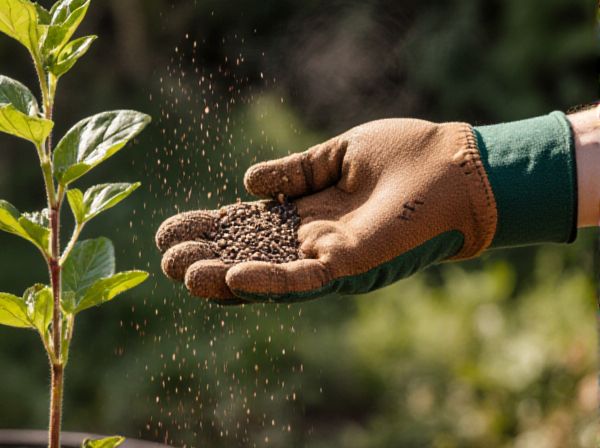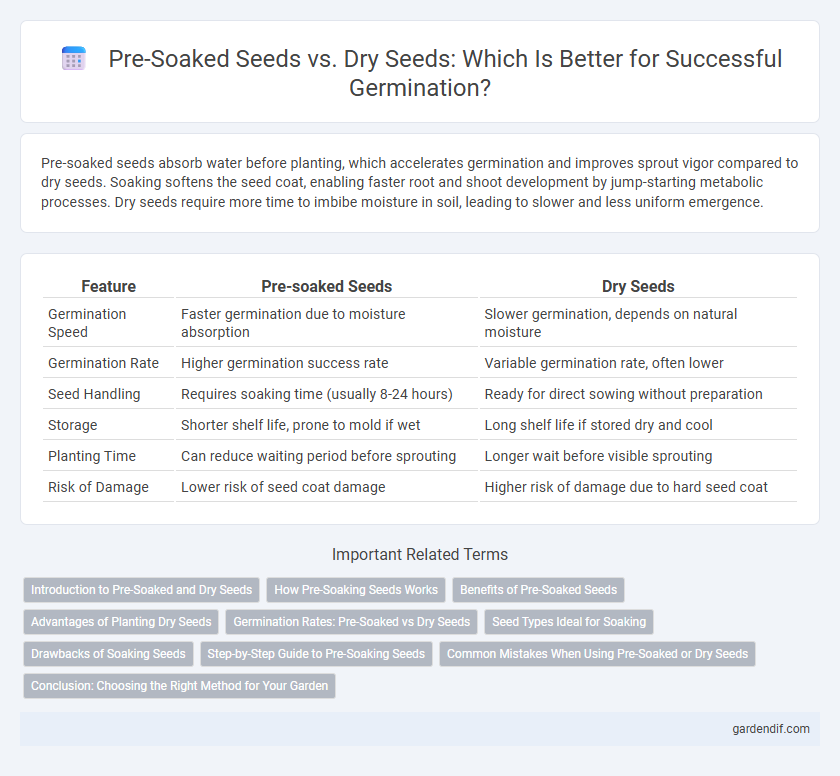
Pre-soaked seeds vs Dry seeds Illustration
Pre-soaked seeds absorb water before planting, which accelerates germination and improves sprout vigor compared to dry seeds. Soaking softens the seed coat, enabling faster root and shoot development by jump-starting metabolic processes. Dry seeds require more time to imbibe moisture in soil, leading to slower and less uniform emergence.
Table of Comparison
| Feature | Pre-soaked Seeds | Dry Seeds |
|---|---|---|
| Germination Speed | Faster germination due to moisture absorption | Slower germination, depends on natural moisture |
| Germination Rate | Higher germination success rate | Variable germination rate, often lower |
| Seed Handling | Requires soaking time (usually 8-24 hours) | Ready for direct sowing without preparation |
| Storage | Shorter shelf life, prone to mold if wet | Long shelf life if stored dry and cool |
| Planting Time | Can reduce waiting period before sprouting | Longer wait before visible sprouting |
| Risk of Damage | Lower risk of seed coat damage | Higher risk of damage due to hard seed coat |
Introduction to Pre-Soaked and Dry Seeds
Pre-soaked seeds are seeds that have been immersed in water for several hours to jumpstart the germination process by softening their outer coat, leading to faster and more uniform sprouting. Dry seeds, in contrast, are stored in their natural, dormant state and require soil moisture to initiate germination, which may result in slower or less consistent growth. Understanding the differences between pre-soaked and dry seeds helps gardeners and farmers choose the best method for optimal seedling development and improved crop yield.
How Pre-Soaking Seeds Works
Pre-soaking seeds involves immersing them in water for several hours to initiate the germination process by softening the seed coat and activating enzymes critical for growth. This technique accelerates water absorption, enabling faster breakdown of stored nutrients and promoting quicker sprout development compared to dry seeds. As a result, pre-soaked seeds typically exhibit higher germination rates and more uniform seedling emergence.
Benefits of Pre-Soaked Seeds
Pre-soaked seeds demonstrate faster germination rates and improved seedling vigor compared to dry seeds, enhancing early plant development. Soaking seeds softens their outer coat, accelerating moisture absorption and enabling quicker metabolic activation necessary for sprouting. This method also reduces the risk of seed rot and increases uniformity in germination, ensuring a higher success rate in crop establishment.
Advantages of Planting Dry Seeds
Planting dry seeds offers extended shelf life and improved storage flexibility compared to pre-soaked seeds, reducing the risk of mold and premature germination. Dry seeds are easier to handle and transport, maintaining their viability until optimal planting conditions arise. This method supports better control over germination timing, enhancing seedling establishment in diverse agricultural environments.
Germination Rates: Pre-Soaked vs Dry Seeds
Pre-soaked seeds generally exhibit higher germination rates compared to dry seeds due to the rapid absorption of water that activates metabolic processes necessary for sprouting. Soaking seeds beforehand can reduce germination time by softening seed coats and leaching out germination inhibitors, which promotes more uniform and vigorous seedling development. Dry seeds, while easier to store and handle, often have slower and less consistent germination, especially in challenging soil conditions.
Seed Types Ideal for Soaking
Legumes such as lentils, chickpeas, and beans are ideal for pre-soaking due to their hard seed coats that benefit from hydration to speed up germination. Small seeds like basil or lettuce typically do not require soaking as their delicate seed coats absorb moisture quickly on their own. Hardier seeds with tough outer shells respond best to soaking, which softens the seed coat and improves water uptake, leading to more uniform and faster seedling emergence.
Drawbacks of Soaking Seeds
Soaking seeds can lead to premature sprouting, reducing their shelf life and viability if not planted immediately. Excess moisture increases the risk of fungal growth and seed rot, especially without proper drying or aeration. Over-soaking may leach essential nutrients, weakening seedling vigor compared to dry seeds.
Step-by-Step Guide to Pre-Soaking Seeds
Pre-soaking seeds accelerates germination by softening the seed coat, allowing water to penetrate more easily and activating the growth process. To pre-soak seeds, submerge them in room-temperature water for 12 to 24 hours depending on the seed type, then drain and plant immediately to avoid seed rot. This method improves germination rates for hard-coated seeds like beans, peas, and sunflowers while reducing the wait time compared to planting dry seeds directly.
Common Mistakes When Using Pre-Soaked or Dry Seeds
Common mistakes when using pre-soaked seeds include over-soaking, which can lead to seed rot and reduced germination rates. Dry seeds are often sown too deep, preventing proper sprouting and root development. Both methods require careful attention to moisture levels and planting depth to ensure optimal seedling growth and healthy crop yields.
Conclusion: Choosing the Right Method for Your Garden
Pre-soaked seeds often exhibit faster germination rates and higher success in controlled environments, making them ideal for gardeners aiming for quick, uniform sprouting. Dry seeds provide greater flexibility in storage and planting timing, preserving viability over long periods and adapting well to natural soil conditions. Selecting between pre-soaked and dry seeds depends on specific garden goals, climate factors, and seed type requirements to optimize growth and yield.
Pre-soaked seeds vs Dry seeds Infographic

 gardendif.com
gardendif.com